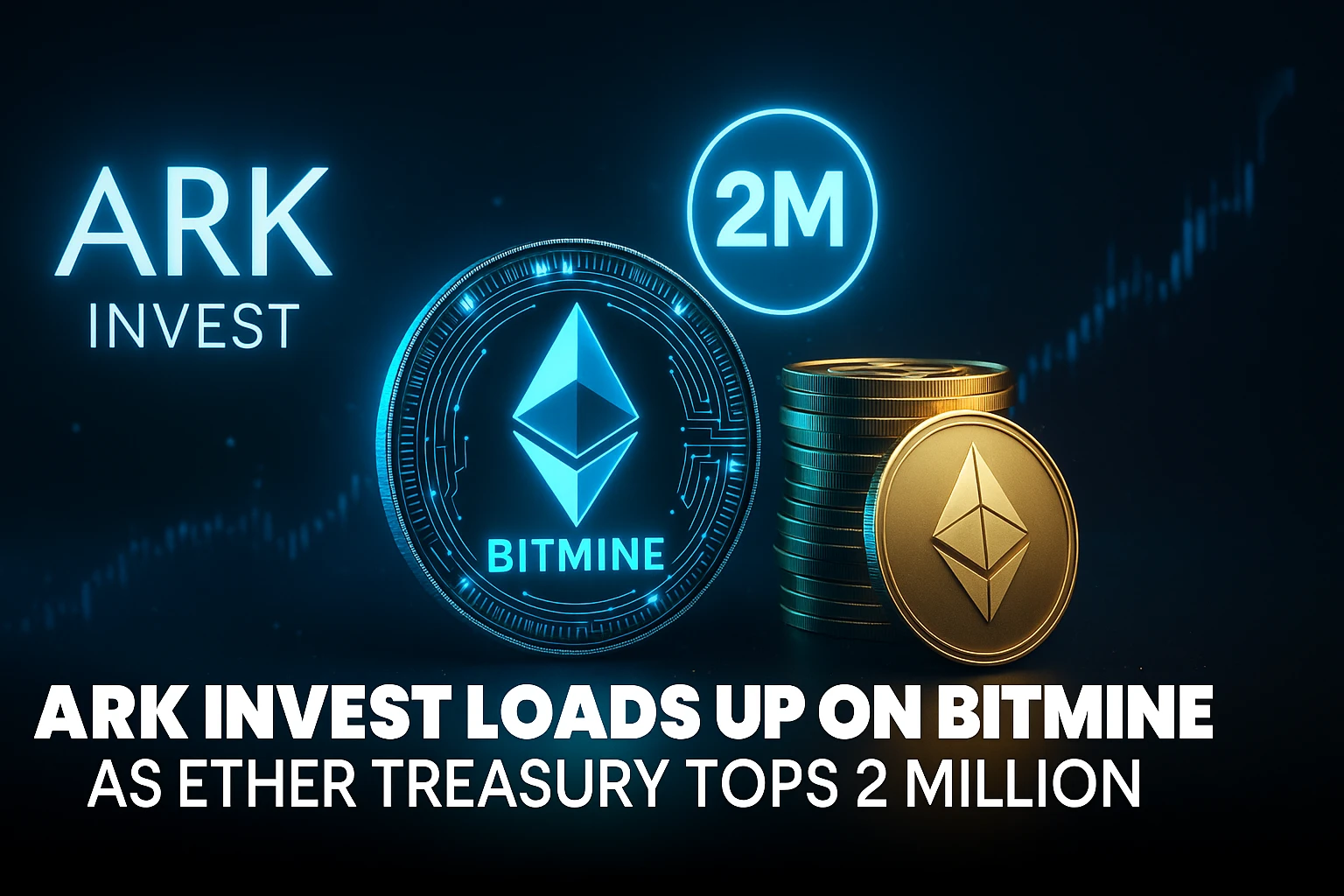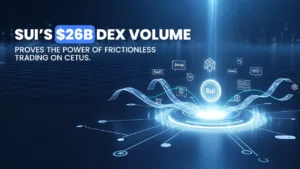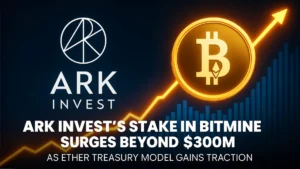ARK Invest Loads Up on BitMine as Ether Treasury Tops 2M, Robinhood Trim Shows Clear Rotation

ARK Invest increased its exposure to BitMine Immersion Technologies as the company’s Ether holdings crossed 2 million. The latest trade extends a buying streak that began in July and continued through early September. It also came alongside sales of Robinhood, signaling a further tilt toward Ethereum balance‑sheet plays over retail brokerage exposure.
- What Happened Actually
- ARK Invest’s Pivot From Robinhood
- How ARK Built The Position
- BitMine’s Treasury Keeps Expanding
- Data Points At A Glance
- ARK Invest’s BitMine Trades And BitMine’s Recent ETH Buys
- Market Reaction to ARK Invest’s Buying Frenzy
- Institutional And Regulatory Setting
- Treasury Mechanics And Cost
- Community And Analyst Signals
- Technical And Risk Considerations
- Long-Term Implications
- Conclusion
- Frequently Asked Questions About BitMine 2 million ETH
- How much BitMine stock did ARK Invest buy this week?
- Did ARK also sell any positions recently?
- Why did BitMine buy ETH through OTC desks?
- Does Ethereum use DPoS?
- What is the main risk for BitMine shareholders?
- Glossary of Key Terms
The move lands in a market that now assigns strategic value to staking economics and validator design. While Ethereum runs on proof of stake, investor conversations are also comparing it to Delegated Proof of Stake (DPoS) systems that rely on token voting to select block producers.
Delegated Proof of Stake (DPoS) concentrates operational costs in a smaller validator set, which can lower run‑rate expenses for corporate treasuries that delegate. That framing helps explain how treasury firms model yield, liquidity, and cost across chains, even if the core thesis here remains Ethereum‑centric.
What Happened Actually
On Monday, ARK Invest bought 101,950 BitMine shares for about 4.4 million dollars across ARKK, ARKW, and ARKF, the firm’s three flagship active ETFs. Cointelegraph reported the purchase as BitMine announced its Ether stack had surpassed 2 million coins. The article also noted that the combined ARK Invest funds now hold millions of BitMine shares and that BitMine’s treasury milestone landed on the same day.
This adds to a series of buys across the summer. Two days before the latest move, ARK Invest disclosed 387,000 BitMine shares across its ETFs for roughly 23.5 million dollars, according to a Yahoo Finance recap of trade filings.
ARK Invest’s Pivot From Robinhood
The Block’s trade summary shows earlier sessions in which ARK Invest loaded up on BitMine while trimming Robinhood and other crypto‑adjacent names. In one session last month, ARK Invest bought about 20 million dollars of BitMine and sold roughly 12.7 million in Robinhood, plus smaller reductions in Coinbase and Block. The pattern confirms a rotation inside ARK Invest’s crypto sleeve toward Ether treasury exposure and away from brokerage and payment stocks.
The shift matters for portfolio construction. BitMine’s revenue and valuation narrative track the size and cost of its Ether holdings. Robinhood’s narrative tracks trading activity, net interest, and custody growth. The two trade on different drivers. The allocation choice signals where ARK Invest sees a better risk‑adjusted payoff in current conditions.
ALSO READ: TRON Takes the Lead as US Economic Data Makes Debut on Public Blockchains
How ARK Built The Position
ARK’s exposure did not materialize in a single print. On July 22, ARK Invest purchased 4.4 million BitMine shares across its ETFs. CoinDesk valued that buy at about 116 million dollars based on the day’s pricing; a BitMine press release the same day put the proceeds tied to the transaction at 182 million dollars to be used for additional ETH acquisition.
The gap likely reflects timing and methodology. One used trade estimates at publication, the other used company figures tied to proceeds. Both point to a large, deliberate entry.
Since then, ARK Invest has added in waves, including the 23.5 million dollars disclosed two days ago and the 4.4 million dollars disclosed Monday. The cadence supports a dollar‑cost approach that smooths entry prices across a volatile tape.
BitMine’s Treasury Keeps Expanding
The asset on the other side of this trade is Ether, and BitMine has kept buying. Four days ago, The Block tracked a 64.7 million dollar over‑the‑counter accumulation of 14,665 ETH routed via Galaxy Digital wallets.
That activity sits within a larger arc that pushed BitMine’s wallet balance above 2 million ETH this week. OTC execution reduces market impact and reinforces a preference for negotiated fills over screens when moving size.
The company’s public goal is to build a corporate Ether reserve at scale. The most recent milestone places BitMine among the largest institutional holders of ETH, and the firm continues to signal more purchases ahead.
For risk teams, the mechanics matter. Treasury acquisition through OTC venues improves slippage control. Storage and staking decisions affect yield and liquidity.
Data Points At A Glance
ARK Invest’s BitMine Trades And BitMine’s Recent ETH Buys
| Date | Action | Security or Asset | Size |
| Jul 22, 2025 | ARK bought BitMine shares | BMNR equity | 4.4 million shares. CoinDesk valued at about 116 million dollars |
| Jul 22, 2025 | Company press release on ARK proceeds | BMNR equity | 182 million dollars for ETH purchase program |
| 2 days ago | ARK added more BitMine and Bullish shares | BMNR equity | 387,000 BMNR shares. About 23.5 million dollars |
| Monday | ARK bought again | BMNR equity | 101,950 shares. About 4.4 million dollars |
| 4 days ago | BitMine bought ETH OTC via Galaxy | Ether | 14,665 ETH. About 64.7 million dollars |
| Last month | ARK added BitMine and sold Robinhood | BMNR and HOOD | Bought 20 million dollars of BMNR. Sold 12.7 million dollars of HOOD |
Figures reflect the cited reports on the day of publication. Shares and dollars are rounded for clarity.
ALSO READ: Bravemorning Injects $110M Into TRON Treasury, Expands Equity Stake to 86.6%
Market Reaction to ARK Invest’s Buying Frenzy
Cointelegraph reported BitMine shares up about 4.1 percent on the day of the latest ARK Invest buy, with year‑to‑date performance up sharply. That bounce followed a steady run of ARK Invest allocations and a series of treasury adds by BitMine itself. Day‑to‑day moves aside, the stock’s path continues to track ETH prices, execution quality on treasury adds, and the pace at which ETFs and funds seek proxy exposure to Ethereum.
Flows into treasury equities sit within a broader thesis. Investors who want operational leverage to Ethereum’s staking economy often choose balance‑sheet plays that hold ETH outright. That differs from exposure to exchanges, brokers, or payment companies, where earnings depend on volumes and net interest. The divergence showed in ARK Invest’s trims of Robinhood while adding BitMine.
Institutional And Regulatory Setting
ARK Invest’s positioning is not happening in isolation. CoinDesk’s July coverage framed the initial 4.4 million share block as a strategic push into an Ether treasury company. That came as spot Ether products and staking narratives gained mindshare with institutions. The rotation also followed a period in which ARK adjusted other crypto exposures inside its funds.
Institutional investors tend to weigh validator economics and custody more than retail traders. That is where discussions of Delegated Proof of Stake (DPoS) enter, even when the target asset is ETH.
In DPoS systems, token holders vote for a limited validator set. That can lower operational overhead for corporate treasuries that delegate, but it can also concentrate governance. Delegated Proof of Stake (DPoS) comes up frequently in diligence memos when funds compare staking yield, unbonding terms, and slashing rules across chains.
Treasury Mechanics And Cost
Over‑the‑counter execution through Galaxy in last week’s buy illustrates how treasuries source coins without moving screens. The Block’s tracing of six OTC transfers shows a preference for negotiated fills that minimize slippage and fee drag. For a treasury desk, that choice feeds directly into realized cost basis and accounting for mark‑to‑market swings.
Once assets sit on the balance sheet, staking policy and custody controls define cash yields and risk. Ethereum validators earn priority fees and issuance. DPoS networks push rewards through elected validators and delegators. The structure matters for compounding and for liquidity planning. Delegated Proof of Stake (DPoS) typically allows fast reallocation across validators, but grace periods and unbonding windows still apply. Funds set these rules in advance to avoid forced selling during stress.
Community And Analyst Signals
Tom Lee, BitMine’s chairman and Fundstrat’s co‑founder, has been vocal about ETH’s path. On August 26, he posted that an ETH bottom was likely near 4,300 dollars, a message that circulated widely among traders.
Mark @MarkNewtonCMT again at it.
➡️Calling ETH bottom to happen in next few hours
Tickers: $BMNR $GRNY pic.twitter.com/038efU7cZH
— Thomas (Tom) Lee (not drummer) FSInsight.com (@fundstrat) August 26, 2025
BitMine also posted its milestone on X this week, marking the 2 million ETH threshold and framing it as a step toward a longer‑term accumulation plan.
🧵
1/5BitMine released its latest $ETH and crypto holdings today, revealing:
– 2,069,443 ETH tokens
– 192 Bitcoin $BTC coins
– $264 million cashticker: $BMNR
Chairman: Thomas “Tom” Lee @fundstratLink 🔗https://t.co/IXBwLMvJZ1
— Bitmine BMNR (@BitMNR) September 8, 2025
Community response on trading forums and feeds has tracked the same split that portfolio managers are weighing. One camp focuses on treasury scale, staking yield, and execution. The other tracks valuation multiples, share issuance capacity, and stock liquidity. Both sets of questions are moving the narrative.
Technical And Risk Considerations
Moving to and holding large ETH balances raises operational questions that equity holders should weigh.
First, the acquisition method. OTC trades limit price impact, but they require counterparty diligence and settlement controls. The Block’s tracking of Galaxy’s role highlights why treasury desks rely on a narrow set of counterparties with strong balance sheets and clear reporting.
Second, staking policy. Staking boosts baseline return, yet it introduces lockup rules and slashing risk. On Ethereum, stake can be delegated through liquid staking tokens or operated directly. In DPoS models such as those used by several high-throughput chains, the enterprise delegates stake to an elected set of validators rather than running its own farm. Delegated Proof of Stake (DPoS) offers simplicity, but it magnifies key‑person and governance risk if the top validators control proposal flow.
Third, accounting and disclosure. Treasury equities trade as a levered bet on coin price with inventory risk attached. Reporting on cost basis, impairment, and realized gains can drive volatility around quarter‑ends. Investors should read footnotes and watch for changes to issuance programs that might dilute holders as the balance sheet scales.
Long-Term Implications
For ARK Invest, the growing BitMine line item signals conviction that an Ether treasury can be an efficient way to own the staking economy in a liquid wrapper. For BitMine, more ETH raises the importance of execution discipline, custody depth, and rate capture. If the company continues buying on weakness and sources coins OTC at scale, it strengthens the equity story tied to net asset value growth.
The balance‑sheet strategy also keeps Ethereum in focus while adjacent chains innovate on validator design. DPoS networks will remain a reference point in treasury discussions. If DPoS validators keep unit costs low, corporate delegators may continue to view those chains as ancillary yield venues next to core ETH holdings. For now, the headline is clear. ARK Invest is pressing its bet on a company whose economic engine is a growing pile of Ether.
Conclusion
ARK Invest’s new buy extends a two‑month build into BitMine that began with a large July block and continued through early September. The firm also trimmed Robinhood in prior sessions, signaling a clear preference for Ethereum balance‑sheet exposure over brokerage beta. BitMine’s treasury crossed 2 million ETH this week, and the company kept sourcing coins OTC to manage cost and slippage.
The market read is straightforward. ARK Invest wants direct exposure to Ether’s staking economy in an equity wrapper. The final arbiter will be execution, custody, and disclosure as BitMine chases scale. Delegated Proof of Stake (DPoS) will remain part of the diligence toolkit as analysts compare staking, governance, and cost models across chains, even as Ethereum remains the centerpiece.
Frequently Asked Questions About BitMine 2 million ETH
How much BitMine stock did ARK Invest buy this week?
ARK Invest disclosed a purchase of about 101,950 shares for roughly 4.4 million dollars across three ETFs on Monday.
Did ARK also sell any positions recently?
Yes. Prior sessions included trims to Robinhood and other crypto‑linked equities while ARK added to BitMine.
Why did BitMine buy ETH through OTC desks?
OTC execution helps reduce slippage and manage fills when buying large blocks, which can lower effective cost.
Does Ethereum use DPoS?
No. Ethereum uses proof of stake. DPoS is a variant in which holders delegate voting power to a smaller validator set. Analysts compare them when modeling yield and governance.
What is the main risk for BitMine shareholders?
Execution and custody. The equity trades on Ether exposure, so treasury sourcing, staking policy, and disclosure drive outcomes.
Glossary of Key Terms
- Over the counter: Direct trading with a counterparty off exchange.
- Validator: Node that proposes and attests blocks in a proof‑of‑stake network.
- Delegated Proof of Stake (DPoS): Model where token holders vote to elect a limited validator set.
- Slippage: Difference between expected and executed price.
- Cost basis: Average price paid for an asset on the balance sheet.
- Unbonding: Cooling period before staked tokens can be withdrawn.
- Staking yield: Return earned for helping secure the network.
- Impairment: Accounting charge to reduce carrying value when prices fall.
- Liquidity: Ability to enter or exit positions without moving price.
- Treasury stock: Equity held by the company or acquired for balance‑sheet strategy.




